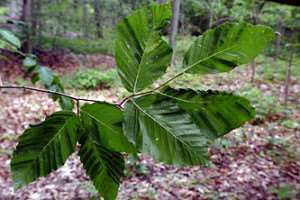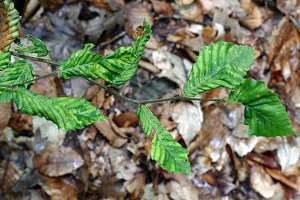Beech Leaf Disease joins the non-native beech scale and its associated beech bark disease (Nectria spp.) as another fatal blow to our native Fagus grandifolia.

Beech Leaf Disease (BLD) may also impact European beech, Fagus sylvatica. The disorder was first described in Lake County, Ohio in 2012. Since then, it has been verified in at least five other counties in northeastern Ohio, as well as Crawford County in northwestern Pennsylvania. Despite the efforts of The Ohio State University Diagnostic Lab and USDA’s Forest Service labs, the cause of BLD remains a mystery.
BLD appears to impact leaves and buds primarily. Initially, several leaves on an otherwise healthy tree appear striped, due to the darkening of the tissue between leaf veins. The striping is most obvious when viewed from below, looking up into the tree canopy. The darkened areas are raised and a bit thicker than surrounding tissue. This may be followed by a lighter, chlorotic-appearing striping.
As BLD progresses, clusters of leaves near the tips of branches appear badly shriveled and distorted, and bud and leaf production are greatly reduced. Buds that do form are small and weakly attached to the twig.

The disease progresses rapidly in saplings and severe decline may occur in a year or two after the initial symptoms appear. In mature trees, the disease seems to move from the lower branches up into the canopy, and progresses slower than it does in saplings. Where BLD is established, 100 percent of American beeches are symptomatic.
While beech is not an important timber species, it is an important part of the eastern deciduous forest ecosystem. American beech provides habit for birds and mammals as well as vital mast for deer, turkey, grouse and many other animals. According to Bringing Nature Home by Doug Tallamy, over 100 species of caterpillars depend on American Beech for food.
While there is much to learn about this new threat to American beech, it can only help to have the eyes of landscape professionals and botanists looking out for its spread in Pennsylvania. The Forestry Division of Pennsylvania’s DCNR would appreciate reports of suspected BLD in Pennsylvania.
Sourece: psu.edu